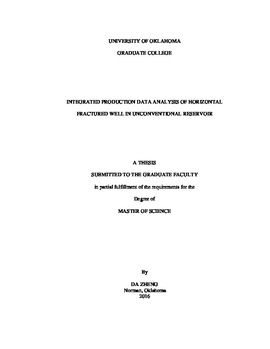| dc.description.abstract | This thesis presents a novel analytical solution to predict the expansion of drainage volume for compound transient linear flow system consisting of stimulated-reservoir volume (SRV) and unstimulated shale/tight sandstone matrix volume. The distance of investigation (DOI) has been demonstrated to be a useful notion for production data analysis; e.g., optimization of spacing of hydraulic fractures, and evaluation of stimulated-reservoir volume (SRV). The DOI concept has been mainly used to evaluate dynamic drainage volume (DDV) for the linear flow system only within SRV. Thus, in view of production from both SRV and unstimulated shale/tight sand matrix; the DOI (or DDV) of transient linear flow in compound multi-stage fractured reservoirs has not been able to be determined yet.
In this work, we derive the DDV equation analytically for compound transient linear flow system under constant-flowing-pressure and constant-production-rate condition for the compound linear flow system. To that end, coupled with the analytical equation calculating the pressure and DDV of linear flow within only SRV, the compound linear flow solution within both SRV and unstimulated matrix is derived. Laplace transform and numerical inversion are implemented to obtain the semi-analytical solution. The pressure front is calculated by implementing the impulse response concept, which is the maximum rate of pressure response. In addition, a relationship was established between DOI and square root of time using multivariable regression, based on the results of 2000 cases calculated from our semi-analytical solution. The cases capture the impact of several parameters, including different diffusivities within SRV and unstimulated matrix, hydraulic fracture length, and fracture spacing.
Our solution suggested that the DOI demonstrates a linear relationship to the square-root-of-time for both linear flow within SRV and the compound linear flow system. The advancement of DDV within stimulated-reservoir volume is significantly faster than that within unstimulated matrix. The majority of production is attributed to size of stimulated-reservoir volume. To verify the accuracy of the new DDV equations, we analyze the synthetic production data from a series of fine-grid numerical simulations.
Employing the DDV model and empirical equation, a novel workflow of integrated production data analysis is proposed to evaluate and predict the performance of multi-stage fractured horizontal well (MFHW). A weak (integral) form of macroscopic mass balance model with moving boundary is developed for the expanding productive region (drainage volume) during long-term transient-flow regimes in non-static shale reservoirs saturated with compressible fluids. The effects of stress-dependent reservoir and pressure-dependent fluid properties on production analysis are incorporated by a pressure-dependent correction factor. To verify the accuracy of our integrated analysis, firstly, we start with a synthetic simulation example with known parameters. In the next stages, several field examples are examined with our integrated analysis approach to evaluate and predict the performance of MFHW.
The size of DDV and associated average reservoir pressure, recovery factor (RF) and average saturation (oil/gas/water) are achieved. The half-length of primary fracture and diffusivity within SRV are also evaluated by coupled with a correction factor, and the ultimate drainage volume (estimated as ultimate recovery, EUR) is also predicated at abandonment condition, which indicates the maximum size of system affected by single-well production for us to optimize well spacing. Moreover, the contributions of both unstimulated-reservoir matrix and stimulated-reservoir volume (SRV) are quantified with changing time, respectively.
The proposed approach has the following novel contributions: (1) capability to ascertain DDV and associated average reservoir pressure throughout different transient-flow regimes; (2) incorporating non-static, fluid compressibility, multi-phase flow and moving flow boundary effects into production history analysis; and 3) simplicity and efficiency; does not require comprehensive inputs as opposed to sophisticated numerical simulations, but could obtain almost all of the necessary parameters for evaluation and prediction. | en_US |
